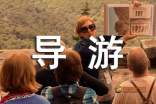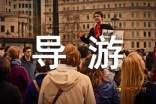关于英文的导游词怎么写
关于英文的导游词怎么写1
Each of the four seasons on Mt. Huangshan has their respective beauty but even this can vary from day to day thanks to variations in the weather, light and shade as clouds pass overhead and even around you at the higher reaches. This endless changing adds an emphasis to the wonder of the landscape and to know the mountain thoroughly, you would need to visit Mt. Huangshan in all the different seasons.

Spring
Mt. Huangshan in spring is like a maiden - all is new, fresh and tender. Spring comes in April but its onset is delayed by three days for every 100 meters as you climb the mountain. Therefore, when wild flowers are brilliant and seedlings are shooting up at its foot, the plants half way up the mountain will be just awakening from their winter sleep and will not exhibit their beauty until a week later. The sound of birdsong is most pleasant in this quietness while you will be enchanted by the color changes as you climb your way up. Spring is probably the most propitious season for visiting Mt. Huangshan and is certainly the best time to view the many waterfalls due to the abundant precipitation.
Summer
It is hard to resist the charm of the cool green mountain sides in summer when an exuberance of plant life covers the valleys and peaks with a green blanket. The green trees and ivy mingle to form natural pavilions where you can sit and refresh yourself while enjoying the beautiful scenery with a cooling breeze to sooth you.
Dawn in summer is most splendid as the rising sun lights the sky and the peaks and the plants and the whole world takes on a brilliant glow. After a storm, Mt. Huangshan becomes a world of water. Numerous streams and waterfalls compose an exciting and vigorous symphony. The Sea of Clouds during this season is not as vast as during autumn or winter but it revels in its brightness. If you are really lucky you will see a vivid rainbow flying over two peaks. Sunset is no less enchanting than sunrise. Mt. Huangshan in summer is the best resort in which to escape high temperatures of southern China.
Tips:
1. July and August are among the peak seasons therefore reservation is a must.
2. It is wise to bring a rainproof jacket with you as the strong wind on the mountain renders an umbrella all but useless and even dangerous.
3. Do not climb the mountain during thunderstorm.
Autumn
Autumn on the mountain is colorful due to the blue sky, white clouds, red maples and yellow fruits. At this time of the year the scenery can be compared with that of spring but with a mature beauty. If spring is like a bud ready to bloom, autumn is a flower showing its last significance before withering. Such is the beauty of the autumn scenery of Mt. Huangshan that it can be seen in many famous Chinese paintings.
Tips:
1.Besides the Golden Week of the National Day (Oct 1st to 7th), September and October are also peak seasons of Mt. Huangshan.
2. Bring with you warm clothes so as not to catch a chill as the temperature variation is significant.
Winter
Snowy Mt. Huangshan is like a crystal palace. Though winter lasts a long time in Huangshan, it is not as cold as you might expect. A poem has it that Mt. Huangshan is beautiful all year round but with the winter scenery being the best. The Sea of Clouds, one of the four wonders of Mt. Huangshan, appears more often in winter than in any other season. The spectacle of rimed trees sparkling in the sun is the privilege of winter alone for it is then that you may find yourself in a silver world with icy peaks, clusters of frosty corals suffused with a plentiful supply of the freshest of oxygen rich fresh air.
Travel tips:
1. Winter is the most economical time for visiting Mt Huangshan as the prices for hotels and the entry fee are lowered by 15% to 40% compared to those of the peak season. However, Spring Festival is an exception, during which the price is the same as normal seasons.
2. The hotels are centrally heated so you don’t have to worry about the cold.
3. Anti-skid shoes are provided as well as heavy coats in most hotels.
关于英文的导游词怎么写2
Yungang Caves, one of China’s four most famous "Buddhist Caves Art Treasure Houses", is located about sixteen kilometers west of Datong, Shanxi Province. There exists 53 caves, most of which are made during the Northern Wei Dynasty between 460 and 494 AD, and over 51, 000 stone sculptures. It extends one kilometer from east to west and can be fallen into three major groups.
The first group (including Cave 1, Cave 2, Cave 3 and Cave 4) are at the eastern end separated from others. Cave 1 and Cave 2 have suffered from rigors of time and the weather. Cave 3, an afterthought after the Northern Wei Dynasty, is the largest grotto among Yungang caves.
Tours normally begin from the second group ranging from Cave 5 to Cave 13.Yungang art manifests its best in this group. Cave 5 contains a seated Buddha with a height of 17 meters. In Cave 6, a 15-meter-high two storey pagoda pillar stands in the center of chamber and the life of the Buddha from birth to the attainment of nirvana is carved in the pagoda walls and the sides of the cave. The Bodhisattva was engraved in Cave 7. The rare seen Shiva Statue in Yungang with eight arms and four heads and riding on a bull is illustrated in Cave 8. Cave 9 and Cave 10 are notable for front pillars and figures bearing musical instruments. Musicians playing instruments also appear in Cave 12. Cave 13 has the Buddha statue with a giant figurine supporting its right arm.
The rest caves belong to the third group. Cave 14 has eroded severely. Cave 15 is named as the Cave of Ten Thousand Buddha. The caves numbered 16 to Cave 20 are the oldest complex and each one symbolizes an emperor from the Northern Wei Dynasty and the subject of "Emperor is the Buddha" is embodied. The caves from No. 21 onward are built in the later times and can not compare to their better preserved counterparts.


